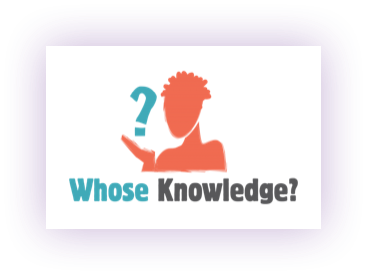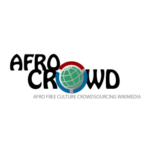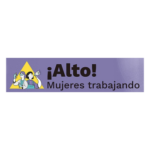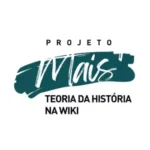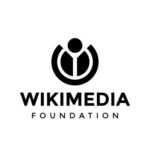Our Resistance is Plural: Feminist Solidarity, Liberation, and Peace

2024 marks the 7th year and edition of the #VisibleWikiWomen campaign.
For the past six years, we’ve brought together a collective of partners and friends worldwide to make images of womxn, especially black, brown, indigenous, and trans, and non-binary individuals, available on Wikipedia and the broader internet. We are proud and grateful for the thousands of images the campaign has brought online and all the events, reflections, and interventions we have done through #VisibleWikiWomxn.
The Issue Remains…
Women’s knowledge and contributions to the world are invisible in many ways. When we look at women’s invisibility online, Wikipedia is a good proxy to explain why this is such a critical issue. Less than ¼ of Wikipedia biographies represent women. Many biographies of important and influential women don’t exist or are incomplete.
More often than not, women’s biographies don’t have images. We estimate that less than 20% of Wikipedia articles of important women have pictures. Only 21% of the images that depict human beings on Wikimedia Commons represent women (according to https://humaniki.wmcloud.org).
When women’s faces are missing from Wikipedia, that invisibility spreads. Half a billion people read Wikipedia every month, and it is in the top 10 most visited websites in the world. In other words, gaps on Wikipedia have a big impact on the broader internet in the world.
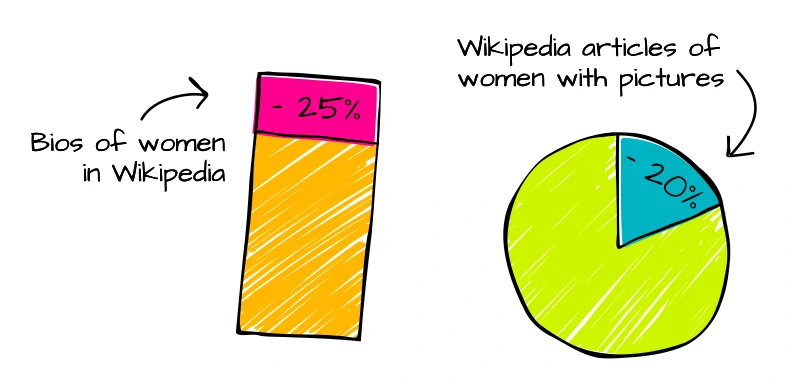
Those visibility gaps on Wikipedia and the broader internet widen even further when women are black, brown, trans, disabled, indigenous, not thin, or exist at the intersections of those multiple oppressions and vulnerabilities.
Theme of the year: Our Resistance is Plural
2023 was such an incredible year for the campaign as we set out to celebrate the plurality of our bodies with our theme #BodyPlurality #CuerposPlurales #CorposPlurais #Imizimba: Celebrating the uniqueness of our body sizes, shapes, and identities online.” Collectively, we surpassed our goal and brought over 3000+ images to Wikimedia Commons of bodies of all sizes, colors, and shapes; bodies that occupy workspaces, sports arenas, stages, and streets with the glorious plurality we want to see online and on wiki.
We are still unpacking what #BodyPlurality is for us and our friends, partners, and allies for whom we do this work of challenging the “standards of beauty” and whose bodies are deemed acceptable, celebrated, and visibilized. The spirit of feminist body politics and all our learnings continue to inspire us and remain at the heart of #VisibleWikiWomen.
2024 also bears a heavy burden of collective rage and grief as the masters’ tools continue to be weaponized against our bodies, our communities, and our lands.
The #VisibleWikiWomen campaign this year reiterates that all of our struggles are interconnected, and our resistance is plural, as the extraordinary feminist human rights and land defender Berta Cáceres said. Guided by Audre Lorde’s teaching that we do not live single-issue lives, from Sudan to Palestine, from reproductive justice to knowledge justice to climate justice, the 2024 campaign will highlight images and stories of the work of our collective liberation:
- Peace thinkers and builders, like Margo Okazawa-Rey and Gwyn Kirk, who were key to framing a “Feminist Vision of Genuine Security“.
- Madres y Abuelas de Plaza de Mayo, the famous Argentinian human rights activists whose peaceful protest is a worldwide icon of popular struggle for truth, justice and memory.
- The continuous waves of street protesters against gender violence, mobilizing from Argentina under the hashtag #NiUnaMenos to Kenya, with #StopKillingWomen and #StopFGMInGambia in The Gambia.
- The tireless seekers of justice for black women like Marielle Franco, indigenous women and land defenders like Berta Cáceres, and trans activists like Alejandra Ironici, and many others whose lives continue to amplify our multiple struggles.
- LGBTQ+ people and activists in Uganda, Ghana, and everywhere homophobic legislation and far-right regression of human rights are taking root.
- Queer and Trans Dalit scholars, journalists and activists who continue to topple caste hierarchies, binaries and normativities to make way for hope, joy and love.
- The feminists and women in Palestine, Sudan, Congo, Western Sahara, and beyond, who are organizing in the face of genocide and war, showing us feminist resistance, liberation, hope, and solidarity in practice.

We are in a context where violence, conflict, and war have developed the worst face of a pedagogy of cruelty, exacerbated by technology, mainstream media, and digital spaces beholden to capitalist and racist agendas. Wherever womxn are, they are disproportionately affected by conflict and violence. But womxn are also relentlessly organizing in solidarity and resistance against systems of oppression — colonialism, patriarchy, white supremacy, racism, casteism, homophobia, transphobia, capitalism, the military-industrial complex, and more. We must recognize where we are in history and contribute to feminist efforts everywhere to document our rage, celebrate our full humanity, and highlight stories and images of feminist resistance, liberations, solidarity, and peace.
With our 2024 theme: “Our Resistance is Plural: Feminist solidarity, liberation, and peace,”
We invite our partners, allies, friends, and comrades in the revolution for our collective freedom to the 2024 #VisibleWikiWomxn campaign:
- To invoke and create our feminist memory and bear witness to the possibilities of radical solidarity and justice,
- To acknowledge the gendered impacts of war and conflict, making the work of womxn peacebuilders and human rights defenders visible through images that represent power, strength, respect, dignity, protest, and solidarity,
- To celebrate the plural ways feminists connect multiple struggles for liberation in response to intersecting forms of systemic oppression. Because nobody is free until everybody’s free.
Our goal for 2024
Our goal for this 7th edition of #VisibleWikiWomen is to bring other 3000 images of women and non-binary individuals to Wikimedia Commons, the big multimedia library for all Wikimedia projects, including the +300 language versions of Wikipedia.
Once again, we will be focusing on increasing the number of images of influential Black, Brown, Indigenous, Trans women and Non-Binary people that are being uploaded to Wikipedia as part of the #VisibleWikiWomxn campaign.
To reach this goal, we invite you – women’s and feminist organizations, culture and memory institutions, Wikipedia editors, user groups, chapters, and anyone who would like to give the plurality of women and non-binary people the visibility and acknowledgement they deserve. We are excited to collaborate with previous year’s friends, allies, and co-conspirators again and to welcome new partners from around the world.
Key moments of 2024
#VisibleWikiWomen is now a yearly campaign, but certain celebrations and commemorations of the year can work as special moments to engage. We want to highlight the following key moments for our communities throughout the year:
- March: International Women’s Day #8M
- April: Dalit History Month, Freedom Day in South Africa
- 1 May: Workers’ Day, a moment to celebrate all women in their workplaces
- June: LGBTQIA+ Pride Month
- July: #DisabilityPrideMonth
- 31 August: International Day for People of African Descent and Women’s Month [SA]
- 5 September: International Indigenous Women’s Day
- 28 September: International Safe Abortion Day
- October: Black History Month [UK, Ireland, The Netherlands]
- 25 November to 10 December: 16 Days of Activism against Gender-based Violence
- And more…
How to participate
You can join the #VisibleWikiWomen campaign all year long, by gathering and uploading quality images in the public domain, or under free license, to Wikimedia Commons under the VisibleWikiWomen category. These images can be photographs or drawings of women, as well as images of their work, with proper consent.
Besides uploading images to Commons, you can also participate in the campaign by:
- Hosting or attending local events in your communities where photos can be taken or uploaded
- Releasing your existing photos of women and non binary people under free licenses
- Creating illustrations and drawings
- Promoting and publicizing this project by spreading the word about it and using the hashtags #VisibleWikiWomen, #VisibleWikiWomxn,#LuchasMultiples #OurPluralResistance#WomenofColors, #on Facebook, Twitter, and Instagram.
- Co-organizing and hosting an online event with Whose Knowledge? to bring the campaign to your local communities
- Creating a feminist corner at your public events, by installing a #VisibleWikiWomen photobooth.
And probably so much more! We’d love to see you come up with new ideas that make sense for you and your communities.
If you need extra support for participating in the campaign, please email us at visiblewikiwomen[at]whoseknowledge[dot]org.
How to get involved?
Content

‣ Help make our campaign multi-lingual by translating our Meta page, resources kit, and the campaign pages of our website into different languages.
‣ Make lists of Wikipedia women biographies without images (by country, by occupation, by century, by activity) to raise awareness of the gender visual gap and create interesting challenges for participants.
‣ Write a new Wikipedia article inspired by an “orphan” women portrait (an image without an article) and use that image to illustrate it.
Spread the word

‣ Curate and share: select images you love, and optionally mix them with inspiring texts and art, and just share it with the hashtags #VisibleWikiWomen and/or #LuchasMultiples #OurPluralResistance.
‣ Collaborative covering: if you are a journalist, a blogger, a podcaster, or you just like to spread ideas online, you can create a piece of content about the campaign.
‣ Find all you need to know for sharing the campaign in our Social Media Toolkit (PDF).
Support the campaign

‣ If you are a feminist organization, cultural and memory institution, media or other potential partner organization, become an institutional partner
‣ If you are an individual connected to potential partners (like the ones mentioned above), please introduce them to the campaign!
If you are connected with potential funders who may be able to fund and support this campaign, please bring them to the campaign!
‣ If you want to volunteer to support this year’s campaign, drop us a line at visiblewikiwomen[at]whoseknowledge[dot]org. There’s always room to welcome new allies!
‣ If you would like to financially support this year’s campaign, click here:
What we’ve done so far
In 2018, we launched the VisibleWikiWomen pilot edition, followed by other four successful campaigns in 2019, 2020, 2021 and 2022. Highlights from our last year’s campaign include:
- 2022 marked the 5th edition of the #VisibleWikiWomen campaign. Launched on March 8, under the theme Hope and healing: Creating feminist memory online. in 2022, #VisibleWikiWomen counted 1,194 images uploaded to Wikimedia Commons, illustrating pages in 9 different Wikipedias plus Wikidata, by 123 participants, 37 of them new editors. All these images together total 53,096 page views.
- Having realized that the #VisibleWikiWomen program coordination would ideally be a full-time position and not a time-bound one, we’ve been working on expanding the team and have hired a full-time #VisibleWikiWomen program coordinator, Sunshine Fionah Komusana, and a communications co-lead, Youlendree Appasamy, who started working with us in June and July 2022, respectively.
- As part of Women’s Month celebration, we co-hosted the regional campaign ¡Alto, Mujeres trabajando!, in partnership with Wikimedia chapters in Latin America, with the aim of making women visible in professions and roles that have historically been dominated by men.
- We made a two-episode podcast series of interviews in celebration of #PrideMonth and as part of the #VisibleWikiWomen campaign. In these interviews, we featured: Arya Jeipea on “our existence is our truth” and Letícia Carolina Nascimento em “nada sobre nós sem nós”.
- In the backdrop of the celebration of the United Nations International Day for People of African Descent on August 31, 2022, we held an editathon in partnership with the collective 500 Women Scientists, to celebrate the contributions of women and non-binary people of African descent in STEM and to ameliorate the erasure of their labor, voices, and stories on Wikipedia, Wikidata and Wikimedia Commons.
- In September, we continued to focus on the theme of celebrating women and queer people in workplaces that have historically excluded them. In partnership with Flickr and the Flickr Foundation, we held a photo-a-ton to celebrate the women and non-binary people who work in historically cis-male-dominated workplaces, and the history of their fight for labor rights (maternity leave, equal pay, bathrooms, sexual harassment legislation, etc.).
- On September 2022 we brought the #VisibleWikiWomen campaign physically to the Forum on Internet Freedom in Africa #FIFAfrica2022, in Lusaka, Zambia, to document the presence of African women digital rights defenders and leaders at the conference.
Our partners & friends
- Women in Red
- Art + Feminism #NowEditingAF
- Association CLibre #CLibreTn
- Global Fund for Women
- Mujeres latinoamericanas en Wikimedia
- O Foundation
- Open Foundation West Africa #OFWAFRICA
- The Black Lunch Table #blacklunchtable
- WikiDonne (#WikiDonne)
- Wikimedia Argentina
- Wikimedia Bolivia
- Wikimedia Community User Group Brazil
- Wikimedia Israel #WikimediaIL
- Wikimedia Tunisie #WikimediaTN
- Wikimedia Uruguay
- Wikimujeres
- Women in Red #WikiWomenInRed
- Women in Red
- Amical Wikimedia
- Art + Feminism #NowEditingAF
- Association CLibre #CLibreTn
- Association for Women’s Rights in Development (AWID)
- Biblioteca Daniel Cosío Villegas (Mexico)
- Women and Memory Forum
- Global Fund for Women
- Global Voices
- International Association of Women’s Museums
- Mujeres latinoamericanas en Wikimedia
- O Foundation
- Open Foundation West Africa #OFWAFRICA
- Smithsonian National Portrait Gallery
- Syrian Female Journalist Network
- Techqueira
- The Black Lunch Table #blacklunchtable
- WikiDonne (#WikiDonne)
- Wikimedia Argentina
- Wikimedia Bolivia
- Wikimedia Community User Group Brazil
- Wikimedia DC
- Wikimedia Israel #WikimediaIL
- Wikimedia Nigeria
- Wikimedia Tunisie #WikimediaTN
- Wikimedia Uruguay
- Wikimujeres
- Women in Red #WikiWomenInRed
- Africa is a Country
- African Women’s Development and Communication Network (Kenya)
- Women in Red
- Amical Wikimedia
- Association for Progressive Communications
- Art + Feminism #NowEditingAF
- Association CLibre #CLibreTn
- Association for Women’s Rights in Development (AWID)
- Barbados Museum & Historical Society
- Biblioteca Daniel Cosío Villegas (Mexico)
- Development Alternatives with Women for a New Era
- Ennegreciendo Wikipedia
- Global Fund for Women
- Global Voices
- Gobierno de Entre Ríos (Argentina)
- International Association of Women’s Museums
- International Image Interoperability Framework Consortium
- International Women’s Day Wikipedia Edit-a-Thon 2020
- Mujeres latinoamericanas en Wikimedia
- O Foundation
- Periodicas
- Smithsonian National Portrait Gallery
- Syrian Female Journalist Network
- Techqueira
- The Black Lunch Table #blacklunchtable
- WikiDonne (#WikiDonne)
- Wikimedia Argentina
- Wikimedia Bolivia
- Wikimedia Community User Group Brazil
- Wikimedia DC
- Wikimedia Israel #WikimediaIL
- Wikimedia Nigeria
- Wikimedia Tunisie #WikimediaTN
- Wikimedia UK
- Wikimedia Uruguay
- Wikimujeres
- Women in Red #WikiWomenInRed
- World Pulse #SheTransformsTech
- Association for Women’s Rights in Development (AWID)
- Lankelly Chase
- Wikimedia Argentina
- Wikimedia Uruguay
- Women in Red #WikiWomenInRed
- World Pulse #SheTransformsTech
- African Women’s Development and Communication Network (Kenya)
- AfroCROWD
- Art + Feminism #NowEditingAF
- Association for Progressive Communications
- Association for Women’s Rights in Development (AWID)
- The Black Lunch Table #blacklunchtable
- Alto Mujeres Trabajando
- Flickr Foundation
- Mozilla Foundation
- Take Back the Tech
- Wikimedia Community User Group Brazil
- Wikimedia Argentina
- Wikimedia Uruguay
- Women in Red #WikiWomenInRed
- World Pulse #SheTransformsTech
- 500 Women Scientists
- African Women’s Development and Communication Network (Kenya)
- AfroCROWD
- Art + Feminism #NowEditingAF
- Association for Progressive Communications
- The Black Lunch Table #blacklunchtable
- Alto Mujeres Trabajando
- Flickr Foundation
- GALA Queer Archive
- Mais Teoria da História na Wiki
- Noircir Wikipédia
- Take Back the Tech
- Wiki Editoras Lx
- Wikimedia Foundation
- Wikimedia Community User Group Brazil
- Wikimedia Argentina
- Wikimedia Uruguay
- African Women’s Development and Communication Network (Kenya)
- AfroCROWD
- Art + Feminism #NowEditingAF
- Association for Progressive Communications
- The Black Lunch Table #blacklunchtable
- Alto Mujeres Trabajando
- Flickr Foundation
- GALA Queer Archive
- Mais Teoria da História na Wiki
- Noircir Wikipédia
- Take Back the Tech
- Wiki Editoras Lx
- Wikimedia Foundation
- Wikimedia Community User Group Brazil
- Wikimedia Argentina
- Wikimedia Uruguay
Resources
If you have never uploaded images to Wikipedia or Wikimedia Commons before, don’t worry, we have you covered! We created this #VisibleWikiWomen resource kit, where you will find instructions and practical advice on how to navigate the Wikiverse, especially how to use Wikimedia Commons.
The resource How to upload images to make women visible on Wikipedia and the Internet is particularly useful as it will guide you through the process of uploading images for this campaign.
Other related resources to help you are:
- Getting and giving consent for images on Wikipedia
- How to find images on the internet to illustrate Wikipedia
- Dos and Dont’s for adding images to Wikimedia Commons and Wikipedia
- How to create drawings for Wikipedia
- How to ask for image donations
- How to join VisibleWikiWomen as a campaign organizer in your local context
- Have a photographer present at edit-a-thons to photograph notable women with consent
- Guide for Cultural and Memory Institutions to make women more visible on Wikipedia
…and if you need inspiration, here are some lists of articles that are missing images of women on Wikipedia.
